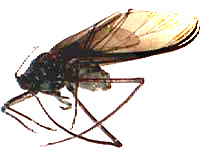Excerpts from Jim Conrad's
Naturalist Newsletter
from the January 20, 2002 Newsletter, issued from near Natchez, Mississippi:
GIANT BARK APHIDS
 For the last couple of weeks large, black aphids about 1/4-inch long (6mm) have been drowning by the dozens in my buckets of rainwater, catching in the fuzz of my sweater, and it seems that at least one is always clambering up through the hair-forest of my legs, tickling as it climbs. They trek along the rims of my buckets and pots in endless circles, until they drop. On some trees they mass in huge numbers. Of course I scanned one for my nature site and you can see it at the right.
For the last couple of weeks large, black aphids about 1/4-inch long (6mm) have been drowning by the dozens in my buckets of rainwater, catching in the fuzz of my sweater, and it seems that at least one is always clambering up through the hair-forest of my legs, tickling as it climbs. They trek along the rims of my buckets and pots in endless circles, until they drop. On some trees they mass in huge numbers. Of course I scanned one for my nature site and you can see it at the right.
To confirm my guess that these were Giant Bark Aphids, LONGISTIGMA CARYAE, I sent the scanned image to the Entomology Department at the University of Mississippi and Evan Nebeker there wrote back, "We have received several reports of the giant bark aphid in your area and surrounding counties." A Web site of the Florida Department of Agriculture says of the aphid that "Severe infestations may result in shoot or branch dieback. Honeydew will damage cars parked under infested trees. Sooty mold prevalent."
It's funny, but even though last week I had been studying aphids and wrote about Turnip Aphids in this Newsletter, when I saw these giant aphids I had no idea what they were. I recall thinking "It's shaped like an aphid, it walks like an aphid, its wing venation is just like an aphid's... I wonder what it is?" It just seemed too large to be an aphid.
Therefore, my preconception about what aphids had to be like -- that they were all tiny -- blinded me to all other evidence. I even ignored the perfectly matching wing venation, which to an entomologist is nearly as important as fingerprints to a criminologist.
So, just what else is there in this life to which I am blind simply because of preconceptions and prejudices? How much richer would my life be and how much more effective as a human would I be if I could bend my mind away from all wrong-headed beliefs I have inherited or accepted through my own intellectual laziness?
As I sit typing this, that question haunts me more than I am bothered by the perpetual tickle of a Giant Bark Aphid climbing upward through my leg hairs.
from the February 10, 2002 Newsletter, issued from near Natchez, Mississippi:
APHID SNACKS
For two days and nights this week the temperature remained just a bit above freezing and it rained almost incessantly. This bone-penetrating chill was surely harder on the birds and other creatures than me.
On Friday for the first time in a long time morning sunlight flooded in from the west. I sat at my campfire feeling its glow on my face and the birds were like so many elves among the tree limbs and Spanish Moss above me. I particularly noticed American Goldfinches, Carolina Chickadees and Myrtle Warblers working along the big branches pecking into the bark. They'd do this a while, then perch in the warming sunlight as if digesting between meals.
My binoculars showed what they were doing. In my Newsletter of January 20 I told you about our outbreak of Giant Bark Aphids. The outbreak continues and they provide snacks for birds working along big tree branches. These aphids suck the tree's sweet sap until they are BB-sized and they must taste like candy to any critter with taste buds sensitive to sweetness.
Despite the birds' depredations among the aphids, the aphids are more than holding their own. Here and there on every Pecan-tree limb and many oak branches there are black splotches looking at first like soot. But close-up the sootiness shows vast gatherings of legs and plump bodies. I fear the aphids may cause infections on these trees, and stunt their growth.
I wonder if some environmental component here has grown so far out of whack that this aphid outburst is a consequence? The way Natchez's paper mill smells 12 miles away when they release their pollution deep in the night when we aren't supposed to notice or care, it could well be something like that.